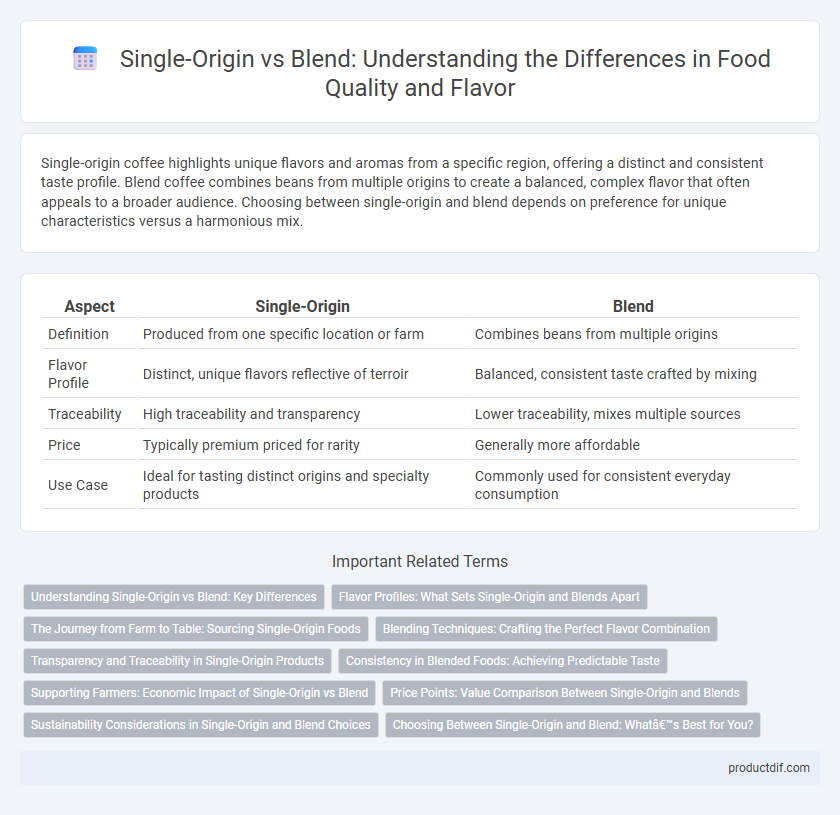Single-origin coffee highlights unique flavors and aromas from a specific region, offering a distinct and consistent taste profile. Blend coffee combines beans from multiple origins to create a balanced, complex flavor that often appeals to a broader audience. Choosing between single-origin and blend depends on preference for unique characteristics versus a harmonious mix.
Table of Comparison
| Aspect | Single-Origin | Blend |
|---|---|---|
| Definition | Produced from one specific location or farm | Combines beans from multiple origins |
| Flavor Profile | Distinct, unique flavors reflective of terroir | Balanced, consistent taste crafted by mixing |
| Traceability | High traceability and transparency | Lower traceability, mixes multiple sources |
| Price | Typically premium priced for rarity | Generally more affordable |
| Use Case | Ideal for tasting distinct origins and specialty products | Commonly used for consistent everyday consumption |
Understanding Single-Origin vs Blend: Key Differences
Single-origin coffee is sourced from a specific region, farm, or producer, offering unique flavors that reflect its geographic and environmental conditions. Blend coffee combines beans from multiple origins to create a balanced, consistent taste that highlights complementary characteristics. Understanding these differences helps consumers choose between the distinct, traceable profiles of single-origin or the harmonious, versatile flavors of blends.
Flavor Profiles: What Sets Single-Origin and Blends Apart
Single-origin coffee offers distinct flavor profiles tied to specific geographic regions, highlighting unique notes like floral, fruity, or earthy characteristics that reflect soil and climate influences. Blends combine beans from multiple origins to create balanced, complex flavors with consistent taste, often achieving a harmonious mix of acidity, body, and aroma. The differentiation lies in single-origin's transparency and terroir expression versus blends' crafted flavor complexity and smoothness.
The Journey from Farm to Table: Sourcing Single-Origin Foods
Single-origin foods trace their journey directly from a specific farm or region, ensuring distinct flavors and transparent sourcing. This precise origin allows consumers to experience the unique terroir, soil, and climate influences in every bite. Detailed farm-to-table tracking enhances sustainability and supports ethical farming practices, making single-origin choices a premium culinary experience.
Blending Techniques: Crafting the Perfect Flavor Combination
Blending techniques involve carefully combining single-origin ingredients to achieve balanced and complex flavor profiles, enhancing taste and aroma. Artisans select components based on complementary characteristics such as acidity, sweetness, and body to create a harmonious final product. Precision in blending ensures consistency and uniqueness, making it essential for premium coffee, chocolate, and wine production.
Transparency and Traceability in Single-Origin Products
Single-origin products offer exceptional transparency by clearly identifying the farm, region, and harvest season, enabling consumers to trace the product's exact origin and production methods. This traceability ensures higher quality control and supports ethical sourcing practices, fostering trust between producers and buyers. In contrast, blends often obscure individual sources, making it harder to verify authenticity and maintain consistent standards.
Consistency in Blended Foods: Achieving Predictable Taste
Blended foods offer unmatched consistency by combining different single-origin ingredients to create a stable flavor profile that remains predictable across batches. Single-origin products can vary due to seasonal changes and regional differences, making them less reliable for maintaining uniform taste. Manufacturers prioritize blending to ensure consumers experience the same high-quality flavor every time they enjoy the product.
Supporting Farmers: Economic Impact of Single-Origin vs Blend
Single-origin coffee directly supports farmers by providing higher premiums and fostering transparent supply chains that emphasize quality and traceability. Blend coffee often relies on beans sourced from multiple regions, potentially diluting economic benefits for individual farmers and reducing incentives for sustainable farming practices. Investing in single-origin products promotes fair trade, empowers farmer communities with stable incomes, and encourages environmental stewardship.
Price Points: Value Comparison Between Single-Origin and Blends
Single-origin coffee often commands higher prices due to its unique flavor profiles and limited production, appealing to specialty coffee enthusiasts willing to pay a premium for quality and traceability. Blended coffee offers a more budget-friendly option by combining beans from various regions, balancing cost and flavor to meet general consumer preferences. Consumers seeking value might choose blends for affordability, while connoisseurs prioritize single-origin for distinctive taste despite the higher cost.
Sustainability Considerations in Single-Origin and Blend Choices
Single-origin coffee supports sustainable farming by promoting traceability, empowering small-scale farmers, and encouraging environmentally friendly practices specific to a region. Blends offer sustainability benefits by utilizing beans from multiple sources, reducing waste through greater flexibility in sourcing and balancing seasonal variations. Choosing between single-origin and blend involves assessing the impact on biodiversity, fair trade certification, and carbon footprint associated with cultivation and transportation.
Choosing Between Single-Origin and Blend: What’s Best for You?
Single-origin coffee offers distinct, traceable flavors from a specific region, highlighting unique terroir characteristics that appeal to those seeking purity and clarity in taste. Blend coffee combines beans from multiple origins to create a balanced, consistent flavor profile suitable for varied palates and daily drinking. Choosing between single-origin and blend depends on your preference for either complex, unique flavor notes or reliable, smooth taste consistency.
Single-Origin vs Blend Infographic

 productdif.com
productdif.com